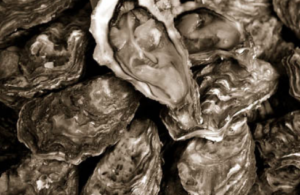 Little did I know what I was in for when I responded to the email invitation from the Food Program : “Come out for a walk with Dan Persyko and friends to marvel at the abundance of food at its source. The traditional First Nations site at Montague Harbour is the ideal place to learn about living close to the land and sea. Bring shovel, a bucket, a bowl, and fork. 4:30 Thursday, June 9th, 2011”.
Little did I know what I was in for when I responded to the email invitation from the Food Program : “Come out for a walk with Dan Persyko and friends to marvel at the abundance of food at its source. The traditional First Nations site at Montague Harbour is the ideal place to learn about living close to the land and sea. Bring shovel, a bucket, a bowl, and fork. 4:30 Thursday, June 9th, 2011”.
What a memorable eveninng, not only because it was a feast, but also because it was such a strong example of how the best, more often than not, comes with simplicity and just getting together for a moment with no agenda. I call that “let’s have a little adventure and see what happens!” I experienced, once again, the natural world as a child would as well as learning many new things.
Having young kids and a dog around is always a treat to watch. To see how they all naturally interact with each other and with the animal, if we trust them enough to admire how they naturally interact and solve simply their differences.
Sea asparagus and bladderack when sautéed with an onion and carrot make a very yummy and healthy serving of veggies (thank God not yet served in those fancy restaurants at a $$$ price, one we gladly pay for with our ignorance).
When you put together pretty big oysters stacked together in a way to allow the juices and sand to flow out with the smaller mussels on top it makes for a 2 part feast. It only took half an hour to gather the food and although at first glance the mussels seemed small they are so tasty. In a big pot with just a little bit of water, steaming on a wood fire right by the beach, the result is absolutely divine.Those big oysters are not that chewy afterall. Both accompanied by our serving of sea veggies, naturally.
When we are still in awe of that fine dinner, Dan and Janice experimented with two different breading for the oysters, so we could have a taste of fried oysters. Dan’s were with flour with garam marsala added. Janice’s were with dipped in beated egg and then rolled in corn flour. Both were delicious and so smooth to enjoy. The little chewiness was even wonderful to get those jaws going.
During the meal, someone mentioned the word ‘wine’ and instantly all said “Naw! Not necessary!” This is as fine as it is! Similarly, at the end, Janice said: “I have a little treat here if you want” (chocolate), and again, all said “it does not belong here”. We simply cleared our plates, and sent the shells back to the beach while watching a couple of grey herons fly over our heads.
Well done, time to go home and stay with that infinite moment of bliss, that is possible to everyone on this island and on top IT IS FREE! NO HST, NO TIPS, NO WAITER, just nature as our generous host!
My conclusion: We live in paradise. Why not work together to enjoy this now and to make it last for all those who come after us.
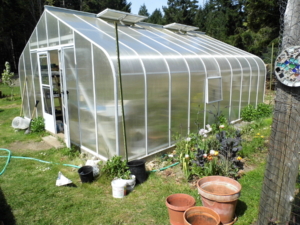 The cold and rainy spring in the unheated greenhouse thwarted our first attempts to grow transplantable vegetable and herbal seedlings in April and May. Undaunted, and with the help of Martine and Janice,we abandoned our miniature and unhealthy starts and planted Martine’s new seedlings. By mid June we were inundated with fresh herbs and furthermore, as of today we have harvested many varieties of tomatoes from Leo and Rosemarie’s starts, cucumbers from seeds , more herbs and are awaiting the ripening of seeded watermelon and cantaloupe.
The cold and rainy spring in the unheated greenhouse thwarted our first attempts to grow transplantable vegetable and herbal seedlings in April and May. Undaunted, and with the help of Martine and Janice,we abandoned our miniature and unhealthy starts and planted Martine’s new seedlings. By mid June we were inundated with fresh herbs and furthermore, as of today we have harvested many varieties of tomatoes from Leo and Rosemarie’s starts, cucumbers from seeds , more herbs and are awaiting the ripening of seeded watermelon and cantaloupe.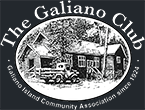
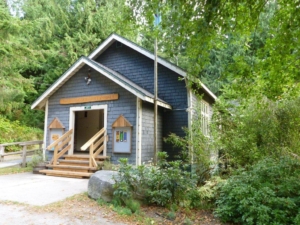 In August, Bob Boyechko and his crew removed 2 old roofs from the South Galiano Community Hall and replaced them with a new roof. The work took about 5 days during the hottest week of the year. No rot was found under the old roofs and the new roof was expertly installed along with new flashings.
In August, Bob Boyechko and his crew removed 2 old roofs from the South Galiano Community Hall and replaced them with a new roof. The work took about 5 days during the hottest week of the year. No rot was found under the old roofs and the new roof was expertly installed along with new flashings.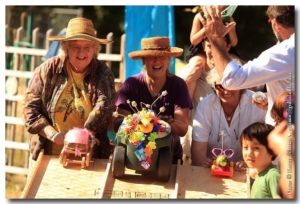 Everyone is invited to Galiano’s first annual Zany Zucchini Races that will be held at the Community Picnic on September 25th at the School/Activity Centre. Ret. Captain Thomas Schnare is co-ordinating the exciting races that will be judged by Mike Hoebel and Dave Agnes.
Everyone is invited to Galiano’s first annual Zany Zucchini Races that will be held at the Community Picnic on September 25th at the School/Activity Centre. Ret. Captain Thomas Schnare is co-ordinating the exciting races that will be judged by Mike Hoebel and Dave Agnes.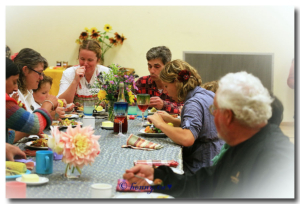 Sunday September 25th from 1-4pm. Gather at the School/Activity centre with friends and neighbours to celebrate the harvest. Potluck lunch starts at 2pm. This year there will also be a Pie Baking contest (bring your best pie to take home the ribbon!) plus Zucchini races (just find your biggest zucchini, add wheels and line up at the start line!), live music from talented locals and a kids vs. parents soccer game. Bring your own plates and cutlery to make clean up easier. So far the following organizations are participating: Library Society, Galiano Naturalists, Chamber of Commerce, Parks & Rec, Lions Club, Galiano Club, Emergency Prepardness Committee, Health Care Society, Galiano Community Food Program and Parents Advisory Committee, Galiano Playgroup Society, North Galiano Fire Protection Society, North Galiano Community Association, Activity Centre plus a number of individuals. But we still need a few more volunteers to help with this fun event.
Sunday September 25th from 1-4pm. Gather at the School/Activity centre with friends and neighbours to celebrate the harvest. Potluck lunch starts at 2pm. This year there will also be a Pie Baking contest (bring your best pie to take home the ribbon!) plus Zucchini races (just find your biggest zucchini, add wheels and line up at the start line!), live music from talented locals and a kids vs. parents soccer game. Bring your own plates and cutlery to make clean up easier. So far the following organizations are participating: Library Society, Galiano Naturalists, Chamber of Commerce, Parks & Rec, Lions Club, Galiano Club, Emergency Prepardness Committee, Health Care Society, Galiano Community Food Program and Parents Advisory Committee, Galiano Playgroup Society, North Galiano Fire Protection Society, North Galiano Community Association, Activity Centre plus a number of individuals. But we still need a few more volunteers to help with this fun event.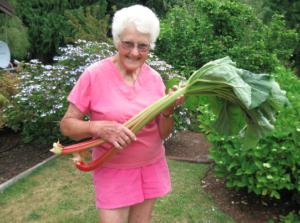 He who plants a tree loves others besides himself – English Proverb
He who plants a tree loves others besides himself – English Proverb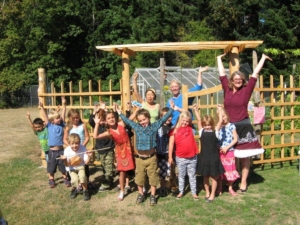 Part of this project was completed with the expanded garden at the school and the raised beds built this past summer by Leo Engelmann and Richard Nathans. New fencing and a new gate was put up by Patrick Sherry and Leo. The vegetables being grown in the raised beds will be used for the Soup for Seniors’ initiative. Another part of this project involves elders working with the school children to identify and inventory the fruit trees and orchards on the island. The kids will be involved in mapping the locations of orchards, helping to identify trees, investigating the history and culture of fruit trees on Galiano. In the Spring we will use this information to do some grafting workshops and ensure that the magnificent fruit trees on the island are “re-born”.
Part of this project was completed with the expanded garden at the school and the raised beds built this past summer by Leo Engelmann and Richard Nathans. New fencing and a new gate was put up by Patrick Sherry and Leo. The vegetables being grown in the raised beds will be used for the Soup for Seniors’ initiative. Another part of this project involves elders working with the school children to identify and inventory the fruit trees and orchards on the island. The kids will be involved in mapping the locations of orchards, helping to identify trees, investigating the history and culture of fruit trees on Galiano. In the Spring we will use this information to do some grafting workshops and ensure that the magnificent fruit trees on the island are “re-born”. Little did I know what I was in for when I responded to the email invitation from the Food Program : “Come out for a walk with Dan Persyko and friends to marvel at the abundance of food at its source. The traditional First Nations site at Montague Harbour is the ideal place to learn about living close to the land and sea. Bring shovel, a bucket, a bowl, and fork. 4:30 Thursday, June 9th, 2011”.
Little did I know what I was in for when I responded to the email invitation from the Food Program : “Come out for a walk with Dan Persyko and friends to marvel at the abundance of food at its source. The traditional First Nations site at Montague Harbour is the ideal place to learn about living close to the land and sea. Bring shovel, a bucket, a bowl, and fork. 4:30 Thursday, June 9th, 2011”. When the opportunity to go to a Canning workshop with one of Bernadin’s top chefs arose, I jumped at the chance. I know a lot about canning, my Grandma taught me to make Jam almost 30 years ago, but there’s always something new to learn. As it turned out – I learned a lot. The biggest realization was that I’m a bit of a jam snob! I make jam the old fashioned way. Long boil, with thermometers, copper pots, and an understanding of the various pectin levels of different fruits at different times of the year. I consider myself an expert at the obscure wrinkle test. And for the last few years I’ve taught “old-school” jam classes through the Galino community Food Program, making hundreds of jars of jam with participants. My Grandmother taught me never to waste food, and I have tried to pass some of those food preserving skills on.
When the opportunity to go to a Canning workshop with one of Bernadin’s top chefs arose, I jumped at the chance. I know a lot about canning, my Grandma taught me to make Jam almost 30 years ago, but there’s always something new to learn. As it turned out – I learned a lot. The biggest realization was that I’m a bit of a jam snob! I make jam the old fashioned way. Long boil, with thermometers, copper pots, and an understanding of the various pectin levels of different fruits at different times of the year. I consider myself an expert at the obscure wrinkle test. And for the last few years I’ve taught “old-school” jam classes through the Galino community Food Program, making hundreds of jars of jam with participants. My Grandmother taught me never to waste food, and I have tried to pass some of those food preserving skills on. What are Community Kitchens?
What are Community Kitchens?